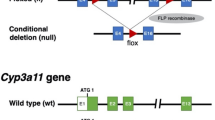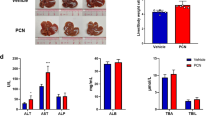Abstract
The cytochrome CYP3A gene products, expressed in mammalian liver, are essential for the metabolism of lipophilic substrates, including endogenous steroid hormones and prescription drugs1,2. CYP3A enzymes are extremely versatile and are inducible by many of their natural and xenobiotic substrates. Consequently, they form the molecular basis for many clinical drug–drug interactions3. The induction of CYP3A enzymes is species-specific4,5, and we have postulated that it involves one or more cellular factors, or receptor-like xeno-sensors6. Here we identify one such factor unequivocally as the nuclear receptor pregnenolone X receptor (PXR)7,8 and its human homologue, steroid and xenobiotic receptor (SXR)8,9,10. We show that targeted disruption of the mouse PXR gene abolishes induction of CYP3A by prototypic inducers such as dexamethasone or pregnenolone-16α-carbonitrile. In transgenic mice, an activated form of SXR causes constitutive upregulation of CYP3A gene expression and enhanced protection against toxic xenobiotic compounds. Furthermore, we show that the species origin of the receptor, rather than the promoter structure of CYP3A genes, dictates the species-specific pattern of CYP3A inducibility. Thus, we can generate ‘humanized’ transgenic mice that are responsive to human-specific inducers such as the antibiotic rifampicin. We conclude that SXR/PXR genes encode the primary species-specific xeno-sensors that mediate the adaptive hepatic response, and may represent the critical biochemical mechanism of human xenoprotection.
This is a preview of subscription content, access via your institution
Access options
Subscribe to this journal
Receive 51 print issues and online access
$199.00 per year
only $3.90 per issue
Buy this article
- Purchase on Springer Link
- Instant access to full article PDF
Prices may be subject to local taxes which are calculated during checkout




Similar content being viewed by others
References
Gonzalez, F. J. Human cytochromes P450: problems and prospects. Trends Pharmacol. Sci. 13, 346–352 ( 1992).
Denison, M. S. & Whitlock, J. P. Xenobiotic-inducible transcription of cyctochrome P450 genes. J. Biol. Chem. 270, 18175–18178 (1995).
Maurel, P. in Cytochrome P450: Metabolic and Toxicological Aspects. (ed. Ioannides, C.) 241–270 (CRC, Boca Raton, Florida, 1996).
Gonzalez, F. J. Molecular genetics of the P-450 superfamily. Pharmacol. Ther. 45, 11–38 (1990).
Nelson, D. R. Cytochrome P450 and the individuality of species. Arch. Biochem. Biophy. 369, 1–10 ( 1999).
Barwick, J. L. et al. Trans-species gene transfer for analysis of glucocorticoid-inducible transcriptional activation of transiently expressed human CYP3A4 and rabbit CYP3A6 in primary cultures of adult rat and rabbit hepatocytes. Mol. Pharmacol. 50, 10–16 (1996).
Kliewer, S. A. et al. An orphan nuclear receptor activated by pregnanes defines a novel steroid signaling pathway. Cell 92, 73–82 (1998).
Blumberg, B. et al. SXR, a novel steroid and xenobiotic-sensing nuclear receptor. Genes Dev. 12, 3195–3205 (1998).
Lehmann, J. M. et al. The human orphan nuclear receptor PXR is activated by compounds that regulate CYP3A4 gene expression and cause drug interactions. J. Clin. Invest. 102, 1016–1023 (1998).
Bertilsson, G. et al. Identification of a human nuclear receptor defines a new signaling pathway for CYP3A induction. Proc. Natl Acad. Sci. USA 95, 12208–12213 (1998).
Wrighton, S. A. et al. Demonstration in multiple species of inducible hepatic cytochromes P-450 and their mRNAs related to the glucocorticoid-inducible cytochrome P-450 of the rat. Mol. Pharmacol. 28, 312– 321 (1985).
Schuetz, E. G. & Guzelian, P. S. Induction of cytochrome P-450 by glucocorticoids in rat liver. II. Evidence that glucocorticoids regulate induction of cytochrome P-450 by a nonclassical receptor mechanism. J. Biol. Chem. 259, 2007– 2012 (1984).
Jones, S. A. et al. The pregnane X receptor: a promiscuous xenobiotic receptor that has diverged during evolution. Mol. Endocrinol. 14, 27–39 (2000).
Savas, U., Griffin, K. J. & Johnson, E. F. Molecular mechanism of cytochrome P-450 induction by xenobiotics: an expanded role for nuclear hormone receptors. Mol. Pharmacol. 56, 851–857 (1999).
Waxman, D. J. P450 gene induction by structurally diverse xenochemicals: central role of nuclear receptors CAR, PXR, and PPAR. Arch. Biochem. Biophy. 369, 11–23 (1999).
Blumberg, B. & Evans, R. M. Orphan nuclear receptors–new ligands and new possibilities. Genes Dev. 12, 3149–3155 (1998).
Pinkert, C. A., Ornitz, D. M., Brinster, R. L. & Palmiter, R. D. An albumin enhancer located 10 kb upstream functions along with its promoter to direct efficient, liver-specific expression in transgenic mice. Genes Dev. 1, 268–276 ( 1987).
Schuetz, E. G., Schinkel, A. H., Relling, M. V. & Schuetz, J. D. P-glycoprotein: a major determinant of rifampicin-inducible expression of cytochrome P4503A in mice and human. Proc. Natl Acad. Sci. USA 93, 4001–4005 ( 1996).
Kolars, J. C., Schmiedlin-Ren, P., Shuetz, J. D., Fang, C. & Watkins, P. B. Identification of rifampin-inducible P450IIIA4 (CYP3A4) in human small bowel enterocytes. J. Clin. Invest. 90, 1871–1878 ( 1992).
Selye, H. Hormones and resistance. J. Pharm. Sci. 60, 1–28 (1971).
Kolars, J. C., Benedict, P., Schmiedlin-Ren, P. & Watkins, P. B. Aflatoxin B1-adduct formation in rat and human small bowel enterocytes. Gastroenterology 106, 433–439 (1994).
Bocherding, S. M., Baciewicz, A. M. & Self, T. H. Update on rifampin drug interactions. II. Arch. Intern. Med. 152, 711–716 (1992).
Hebert, M. F., Roberts, J. P., Prueksaritanont, T. & Benet, L. Z. Bioavailability of cyclosporine with concomitant rifampin administration is markedly less than predicted by hepatic enzyme induction. Clin. Pharmacol. Ther. 52, 453–457 (1992).
Burger, H. -J., Schuetz, J. D., Schuetz, E. G. & Guzelian, P. S. Paradoxical transcriptional activation of rat liver cytochrome P-450 3A1 by dexamethasone and the antiglucocorticoid pregnenolone 16 carbonitrile: Analysis by transient transfection into primary monolayer cultures of adult rat hepatocytes. Proc. Natl Acad. Sci. USA 89, 2145– 2149 (1992).
Hashimoto, H. et al. Gene structure of CYP3A4, and adult-specific form of cytochrome P450 in human livers, and its transcriptional control. Eur. J. Biochem. 218, 585–595 ( 1993).
Ho. S. N., Hunt, H. D., Horton, R. M., Pullen, J. K. & Pease, L. R. Site-directed mutagenesis by overlap extension using the polymerase chain reaction. Gene 77, 51–59 (1989).
Xie, W., Chow, L. T., Paterson, A. J., Chin, E. & Kudlow, J. E. Conditional expression of erbB2 oncogene in transgenic mice elicits striking hyperplasia in stratified epithelia, and up regulation of TGFa expression. Oncogene 18, 3593–3607 (1999).
Yanagimoto, T., Itoh, S., Muller-Enoch, D. & Kamataki, T. Mouse liver cytochrome P-450 (P 450IIIAM1): its cDNA cloning and inducibility by dexamethasone. Biochim. Biophys. Acta 1350, 329–332 (1992).
Jelinek, D. F., Andersson, S., Slaughter, C. A. & Russell, D. W. Cloning and regulation of cholesterol 7-alpha-hydroxylase, the rate-limiting enzyme in bile acid biosynthesis. J. Biol. Chem. 265 , 8190–8197 (1990).
Kimura, S., Gonzalez, F. J. & Nebert, D. W. Mouse cytochrome P3-450: complete cDNA and amino acid sequence. Nucleic Acids Res. 12, 2917 –2928 (1984).
Acknowledgements
We thank K.-F. Lee for ES cells and his advice on ES cultures; Y. Dayn for her assistance in DNA and ES cell microinjections; A. Pierce, H. Juguilon, G. Nelson and I. Ong for technical assistance; J. Simon and M. Lieberman for assistance in photography; and E. Stevens and L.Ong for administrative assistance. W.X. is supported by Susan G. Komen Breast Cancer Foundation. M.D. is a C.J. Martin Research fellow of Australia. R.M.E. is an Investigator of the Howard Hughes Medical Institute at the Salk Institute for Biological Studies and March of Dimes Chair in Molecular and Developmental Biology. This work was supported by Mathers Foundation (R.M.E.), the Howard Hughes Medical Institute (R.M.E.) and grants from the NIH (P.S.G.).
Author information
Authors and Affiliations
Corresponding author
Rights and permissions
About this article
Cite this article
Xie, W., Barwick, J., Downes, M. et al. Humanized xenobiotic response in mice expressing nuclear receptor SXR . Nature 406, 435–439 (2000). https://doi.org/10.1038/35019116
Received:
Accepted:
Issue Date:
DOI: https://doi.org/10.1038/35019116
This article is cited by
-
Effects of rifampicin on hepatic antioxidant enzymes in PXR and CAR double humanized mice
Molecular & Cellular Toxicology (2021)
-
Mutation of a single amino acid of pregnane X receptor switches an antagonist to agonist by altering AF-2 helix positioning
Cellular and Molecular Life Sciences (2021)
-
Implications for dosing regimen of enrofloxacin administered concurrently with dexamethasone in febrile buffalo calves
Tropical Animal Health and Production (2020)
-
Non-genomic effects of the Pregnane X Receptor negatively regulate platelet functions, thrombosis and haemostasis
Scientific Reports (2019)
-
Indirubin-pregnane X receptor-JNK axis accelerates skin wound healing
Scientific Reports (2019)
Comments
By submitting a comment you agree to abide by our Terms and Community Guidelines. If you find something abusive or that does not comply with our terms or guidelines please flag it as inappropriate.



